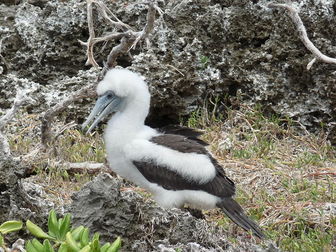Abbott's Booby
Abbott’s Booby is a large endangered seabird of the gannet family, Sulidae. It belongs to the monotypical genus Papasula. Found normally only on and around Christmas Island , it is the sole living member of the genus Papasula. This species is named for William Louis Abbott who discovered it on Assumption Island in 1892.

Original source: Abbott's BoobyUploaded by Richard001
Author: orangeislandOther versionsImage:Abbotts Booby (Papasula abbotti) side on.jpg, Image:Abbotts Booby (Papasula abbotti) facing camera.jpg
The Abbott's Booby is classified as Endangered (EN), considered to be facing a very high risk of extinction in the wild.
The Abbott's Booby now breeds only on Christmas Island, Indian Ocean, although formerly it bred on other Indian Ocean islands. At sea it is mainly seen in the waters around Christmas Island. There is fossil evidence of its former presence in the South Pacific, and eyewitness reports of it formerly breeding on the Mascarene Islands. In April 2007 an individual of this species was photographed at a booby colony on Rota in the Pacific Ocean. More
Abbott's Booby was formerly included in Sula but is now placed in a monotypic genus Papasula which represents an ancient lineage perhaps closer to Morus. Some authorities consider that all nine species should be considered congeneric in Sula. However, they are readily told apart, by means of osteology. The distinct lineages of gannets and boobies are known to have existed in such form, since at least the Middle Miocene, c.15 mya (Olson 1985). More
Abbott's booby, Papasula abbotti, These seabirds feed on fish and squid (3), presumably by plunge diving (5). Adults return to feed their young in the late afternoon and early evening (5), and it is likely that Abbott's boobies rely on cold upwellings near to Christmas Island where there is a seasonal abundance of food (4). More
The breeding population of Abbott's Booby appears to have declined due to the clearance of habitat between 1967 and 1983 and may still be declining due to the low recruitment rate and adverse effects of wind turbulence on breeding performance close to mined clearings. The combination of small population, strict habitat preference, slow reproductive rate and strong site fidelity makes the species susceptible to extinction if further disturbance of habitat occurs There is an Environment Australia Abbott's Booby Recovery Plan currently in progress. More
Abbott's Booby is the rarest and most restricted in distribution of the seven species of Sulidae in the world. Its current population on Christmas Island is estimated at about 2500 breeding pairs. The birds were once more widespread on the island, but due to the destruction of native forest for mine operations their numbers are significantly reduced. The rainforest on Christmas Island is the last remaining habitat of the Abbott's Booby and it is listed as endangered. More
Abbott's booby's secretive habits have resulted in few interactions between this species and humans. Home of Wiki & Reference Answers, the world’s leading Q&A siteReference AnswersEnglish▼English▼ Deutsch Español Français Italiano Tagalog * * Search unanswered questions... * Browse: Unanswered questions | Most-recent questions | Reference library Enter a question here... More
Videos and images Abbott's booby perched on branch Abbott's booby is a large slender-bodied, black-and-white seabird. The head, neck and underparts are white whilst the black upperwing has white flecking and a narrow white leading edge. The white lower back and rump are blotched with black and the ... More
Abbott's booby perched on branch Abbott's booby perched on branchPrint factsheet Facts - Spanish: Alcatraz De Abbott, Piquero De Abbott Kingdom Animalia Phylum Chordata Class Aves Order Pelecaniformes Family Sulidae Genus Papasula (1) More
prospects of Abbott's Booby in relation to the British Phosphate Commissioner's mining and conservation policy. Unpublished report. British Phosphate Commission 5. Garnett, S. (1993) Threatened and Extinct Birds Of Australia. RAOU. National Library, Canberra. ISSN 0812-8014 6. BirdLife International (2006) Species factsheet: Papasula abbotti. Downloaded from http://www.birdlife.org on 17/10/2006 Copyright: Wikipedia. More
Abbott's Booby is seen in the forested areas along the Murray Road particularly around the LB4 Lookout. They fly quite high and can be seen flying to and from their nest from vantage points around the island. More
the Abbott's booby is said to be the only species of gannet to nest on the top of trees instead of on the ground. Females give birth to one egg and incubate it for 42 to 55 days. Both male and female care for the eggs. The hatchling depends on the mother for six to eight months. The main threat to the Abbott's Booby is loss of habitat through forest clearance. The current population is believed to be less than 2000. More
Nice selection of Abbott's booby video clips available in various formats Bluefooted Booby MOV View Movie OceanFootage.com Bluefooted Boobies Bluefooted Booby MOV View Movie OceanFootage.com Bluefooted Boobies Bluefooted Booby MOV View Movie OceanFootage.com Bluefooted Boobies Bluefooted Booby MOV View Movie OceanFootage. More
Life is looking rosier for Abbott's booby, one of the world's rarest birds and a native of Australia's Christmas Island, according to a World Conservation Union (IUCN) report Tuesday. The species of seabird, known as Papasula abbotti, has been moved out of the "critically endangered" category in the IUCN's latest Red List into the slightly more comfortable "endangered" section thanks to conservation measures. More

Original source: Australia Post 
-Australia Post -Author: Australia Post 
Permission: Some rights reserved
Family : Sulidae
Genus : Papasula
Species : abbotti
Authority : Ridgway, 1893

